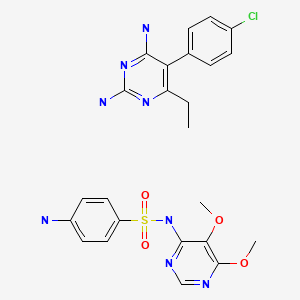CASRN: 37338-39-9

Drug Levels and Effects
Summary of Use during Lactation
Because there is little published experience with sulfadoxine during breastfeeding, an alternate drug may be preferred, especially while nursing a newborn or preterm infant. The manufacturer states that the combination of sulfadoxine-pyrimethamine is contraindicated for prophylaxis during nursing and in children under 2 months of age. However, some authors have found no contraindication to the use of sulfadoxine-pyrimethamine during breastfeeding.[1,2] It has been suggested that maternal pyrimethamine clearance might be increased during lactation, but data are insufficient to make a definitive conclusion.[3,4]
Sulfadoxine-pyrimethamine prophylaxis of the mother should be discontinued at the first appearance in the infant of jaundice, skin rash, if a significant reduction in the count of any formed blood elements is noted, or upon the occurrence of active bacterial or fungal infections.
Drug Levels
Maternal Levels. Relevant published information on sulfadoxine was not found as of the revision date.
Pyrimethamine milk levels have been reported to range from 0.2 to 0.26 mcg/L at 6 hours after doses of 25, 50 or 75 mg in 6 women. Milk levels ranged from 0.125 to 0.155 mcg/L 24 hours after the dose and 0.095 to 0.0105 mcg/L at 48 hours.[5,6]
Three women were given a single dose of pyrimethamine 12.5 mg orally 2 to 5 days postpartum. Milk samples were obtained periodically for about 9 days after the dose. Assuming a daily intake of 1 L of milk, the infants would receive 0.14, 0.21 and 0.34 mg in milk over the study period. These values equate to an average of 46% of the maternal weight-adjusted dosage.[7]
Infant Levels. Relevant published information was not found as of the revision date.
Effects in Breastfed Infants
Administration of pyrimethamine to mothers of 26 predominantly breastfed infants 2 to 6 months old who were infected with malaria was curative in the infants.[6] The regimen consisted of 75 mg followed by a subsequent dose of 50-75 mg 4 to 7 days later. The efficacy apparently is related to breastfeeding habits, because infants in another tribal group who breastfed their infants less extensively were not protected.[5] An additional case report indicates that a maternal dose of 75 mg orally followed by 25 mg weekly cured malaria in her infant and protected her breastfed infant against becoming infected with malaria for 6 months.[7] No adverse effects were reported in any of the infants.
A study of women with HIV infection being treated for presumptive malaria included 12 nursing mothers who were taking the sulfadoxine-pyrimethamine combination. The drug combination appeared to reduce breastmilk viral load less than chloroquine treatment. No mention was made of the effects in breastfed infants.[8]
A cohort of 33 infants who were breastfed (extent not stated) by hospitalized mothers taking nifurtimox was followed in the Democratic Republic of the Congo. Thirty mothers took a full course of 30 doses of oral nifurtimox 15 mg/kg daily and all received 14 doses of intravenous eflornithine 400 mg/kg daily for 7 days for human African trypanosomiasis. (sleeping sickness). Eight mothers also took sulfadoxine-pyrimethamine. No serious adverse events were reported in any of the breastfed infants.[9,10]
Effects on Lactation and Breastmilk
Relevant published information was not found as of the revision date.
Alternate Drugs to Consider
References
- 1.
- Chattopadhyay R, Mahajan B, Kumar S. Assessment of safety of the major antimalarial drugs. Expert Opin Drug Saf. 2007;6:505–21. [PubMed: 17877439]
- 2.
- Peters PJ, Thigpen MC, Parise ME, et al. Safety and toxicity of sulfadoxine/pyrimethamine: implications for malaria prevention in pregnancy using intermittent preventive treatment. Drug Saf. 2007;30:481–501. [PubMed: 17536875]
- 3.
- de Kock M, Tarning J, Barnes KI, et al. Response to "Lactation status and studies of pyrimethamine pharmacokinetics in pregnancy". CPT Pharmacometrics Syst Pharmacol. 2017;6:731. [PMC free article: PMC5702899] [PubMed: 29052341]
- 4.
- Salman S, Davis TME. Regarding "Lactation status and studies of pyrimethamine pharmacokinetics in pregnancy". CPT Pharmacometrics Syst Pharmacol. 2017;6:730. [PMC free article: PMC5702900] [PubMed: 29064165]
- 5.
- Clyde DF. An examination of factors involved in the transfer of pyrimethamine in human milk. East Afr Med J. 1957;34:81–5. [PubMed: 13437933]
- 6.
- Clyde DF, Press J, Shute GT. Transfer of pyrimethamine in human milk. J Trop Med Hyg. 1956;59:277–84. [PubMed: 13385913]
- 7.
- Clyde DF. Prolonged malaria prophylaxis through pyrimethamine in mothers' milk. East Afr Med J. 1960;37:659–60. [PubMed: 13694157]
- 8.
- Semrau K, Kuhn L, Kasonde P, et al. Impact of chloroquine on viral load in breast milk. Trop Med Int Health. 2006;11:800–3. [PMC free article: PMC1765922] [PubMed: 16772000]
- 9.
- Schmid C, Kuemmerle A, Blum J, et al. In-hospital safety in field conditions of nifurtimox eflornithine combination therapy (NECT) for T. b. gambiense sleeping sickness. PLoS Negl Trop Dis. 2012;6:e1920. [PMC free article: PMC3510081] [PubMed: 23209861]
- 10.
- Kuemmerle A, Schmid C, Kande V, et al. Prescription of concomitant medications in patients treated with nifurtimox eflornithine combination therapy (NECT) for T.b. gambiense second stage sleeping sickness in the Democratic Republic of the Congo. PLoS Negl Trop Dis. 2020;14:e0008028. [PMC free article: PMC7004379] [PubMed: 31986140]
Substance Identification
Substance Name
Sulfadoxine and Pyrimethamine
CAS Registry Number
37338-39-9
Drug Class
Breast Feeding
Lactation
Anti-Infective Agents
Antiparasitic Agents
Antimalarials
Antiprotozoal Agents
Sulfonamides
Disclaimer: Information presented in this database is not meant as a substitute for professional judgment. You should consult your healthcare provider for breastfeeding advice related to your particular situation. The U.S. government does not warrant or assume any liability or responsibility for the accuracy or completeness of the information on this Site.
Publication Details
Publication History
Last Revision: May 17, 2021.
Copyright
Attribution Statement: LactMed is a registered trademark of the U.S. Department of Health and Human Services.
Publisher
National Institute of Child Health and Human Development, Bethesda (MD)
NLM Citation
Drugs and Lactation Database (LactMed®) [Internet]. Bethesda (MD): National Institute of Child Health and Human Development; 2006-. Sulfadoxine and Pyrimethamine. [Updated 2021 May 17].